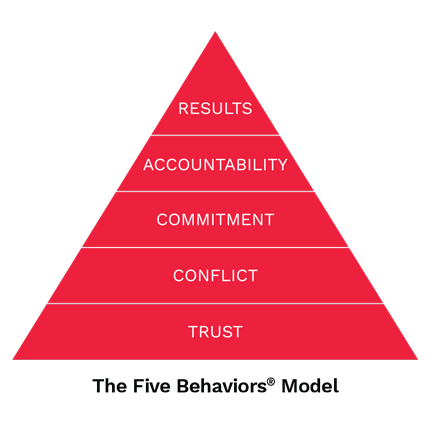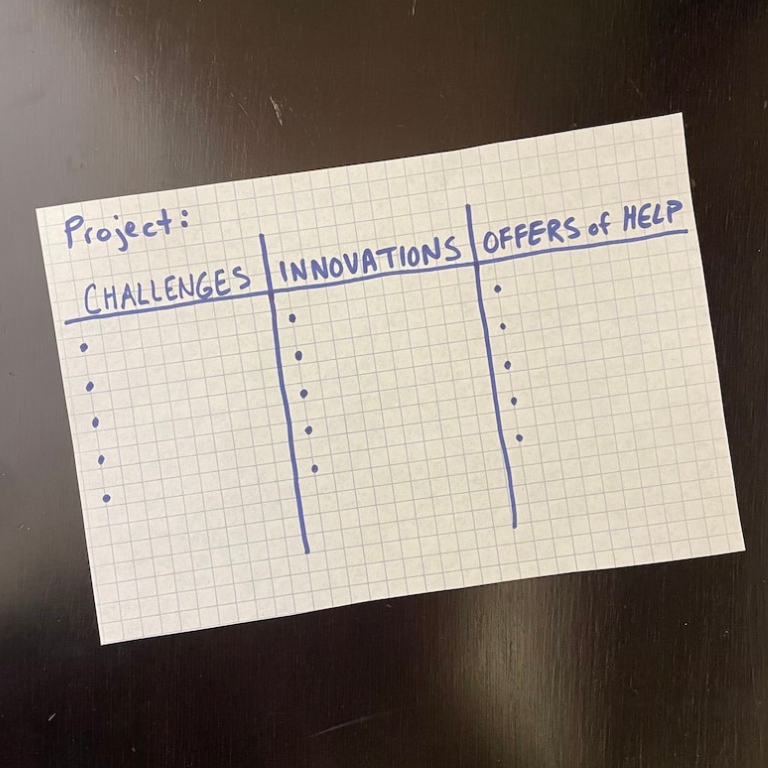Building Team Accountability

Key Takeaways
- The best teams hold each other accountable for their role in reaching team goals. Teams without accountability often see dispirited members, resentment, and missed deadlines.
- Teams can encourage accountability by making goals and standards clear, making necessary resources available, addressing slacking, and building trust.
- Personality assessments, practicing feedback, and team accountability activities can help build a culture of accountability.
Team accountability, defined
Accountability is when team members take responsibility for their work, commitments, and deadlines to achieve the team's goals. Holding another team member accountable is not a function only of the team’s leader; it’s a shared responsibility. If your team struggles with this, you are not alone; many teams find this difficult. Those who don’t show generous, caring, trusting, and supportive behaviors are not showing accountability, but often working only toward their own goals.
Team members who have high levels of accountability don’t just get their own work done, they are engaged with all the work of the team and try to keep the team’s energy high and outlook positive. They help each other succeed through feedback, assistance, coaching, positive recognition, and other supportive behaviors.
Signs of teams that lack accountability
If teams struggle with accountability, you might notice:
- Resentment among team members who have different standards of performance.
- Mediocre and uninspired performance.
- Confusion about direction and priorities.
- Missed opportunities due to excessive analysis or unnecessary delay.
- Repeated discussions about the same decisions or procedures.
- Second-guessing among team members.
- Dispirited and disinterested team members.
- Missed deadlines and deliverables.
- Excessive reliance on bureaucratic procedures and hierarchical structures.
How can teams encourage accountability?
1. Make goals clear
Does your team know why it exists? Can each member express the team’s goals? Do you share a vision of the results you expect to achieve? Does your team exist just because it seems like it should? Has it outlived its purpose?
Have you answered the first question Patrick Lencioni introduces in The Advantage: Why do we exist? Can we all agree on this?
Effective leaders share a strong vision with their teams and have done the work necessary to bring the team into alignment with that vision. Your team’s goals should align with your organization’s. This might seem obvious, but teams can get off track fairly easily.
2. Make standards clear
Does everyone have a clear understanding of their individual roles and responsibilities and those of the other members? Have you set ground rules for the team? Have you answered Lencioni’s second and third questions: How do we behave? What do we do?
Your team has its own culture. Is it the culture you want? Is it supportive of all team members? If your team members have taken an Everything DiSC® assessment, you might want to review and discuss the Everything DiSC Group Culture Report. If someone is feeling marginal to the rest of the group, that might be preventing their peak performance.
Do members understand the consequences of not taking responsibility or taking on more than they should? Are communication channels working effectively? Should communication standards be reexamined?
Is your team’s responsibility interdependent with another team or teams? If so, how and when do you influence each other? Are roles and standards clear across teams?
Make sure you agree on who is ultimately accountable for the results of your team. In some organizations it is the entire team; in others, it is the leader or the chair. To whom are you accountable?
3. Check in regularly
Schedule regular reviews of progress of the team and of the individual team members. This is a time for celebrating reaching milestones and for identifying and solving problems. It’s a time for making new commitments. Perhaps less frequently, it’s a time for analyzing available performance data.
Healthy teams foster a climate where members can speak freely and admit to mistakes and anxieties. Everyone worries more about meeting team goals than making a name for themselves.
Mistakes and struggles are learning opportunities and signals of deeper issues. Commit to the five whys (an iterative interrogative technique) and be proactive about digging into problems and finding solutions as a team. Focus on the future, your team values, and your team goals.
4. Make necessary resources available
If someone doesn’t have the time, equipment, information, or other resources necessary for achieving results, you can’t hold them accountable for poor results. Leaders of teams are responsible for obtaining and distributing resources appropriately.
When setting expectations for team performance, it’s important to ask the team if they feel that they can meet those expectations. What are ways the organization can make it easier for team members to do their jobs? Set the team up for success.
5. Address slacking
If your team has clear standards, anyone not meeting them will know it. But it still needs to be addressed as a group. What is the root of the problem? Is there a lack of trust, commitment, or understanding? Is it a personnel problem or a process problem? Is it an ongoing problem? Is it clear that good intentions aren’t rewarded, but results are?
While we want to avoid direct blame and punishment in order to build a culture of accountability, it’s also important that everyone understands the consequences of not meeting standards. Does your team have the ability to remove nonperformers? If not, who does?
6. Build commitment and build trust
Accountability is just one of the behaviors of a cohesive team. It’s built upon and also builds trust and commitment. It’s easier to challenge someone when the environment feels safe, when people assume good intent, and when everyone has already committed to behaviors and actions.
Can you imagine this scenario? You notice a colleague texting and say, “Hey, I thought we agreed not to use our phones while in meetings” and in response you hear “Yeah, you’re right. I’ll put it away.” Then the meeting continues without any more discussion or attention to the problem.
Can you also imagine this scenario? You’ve waited an extra day for something you need for a report. Your teammate promised to have that to you, so you remind them and ask if there’s a problem. Perhaps a family member fell ill or perhaps your request was lost in a poorly communicated request. No angry words were exchanged, just a discussion to clarify the problem and how to avoid it in the future.
Trust and commitment can make this type of accountability-related interaction on teams possible.
Using assessments to help grow a team’s commitment and accountability levels
Before you know what changes need to be made, you must assess where your team is now. We recommend using an assessment like The Five Behaviors® Team Development. If you discover that the team lacks trust, then that is where the team needs to work before tackling issues of commitment and accountability. Team members have difficulty holding each other accountable if they don’t feel safe in the group.
If the team is ready to tackle these two issues, an assessment will give them some language for discussions and tips for productive actions. The assessment might become the basis for a new set of norms, mores, or a social contract they want to establish.
Teams should commit as a group to the behaviors they want to prioritize and encourage. These should be behaviors that will have the biggest impact on the team’s performance. Keep this number small and return to it later to enlarge or alter the list.
Problem-solve together. Addressing problems as a team will give everyone practice using the behaviors they want to promote. Problems can include those the team has working together and those around achieving the results they have committed to. It can involve shifting the team’s priorities, finding ways to meet competing demands, or adapting to new needs of teammates.
Practice giving feedback. Some teams are great at building each other up, but have a hard time giving tough feedback. Other teams forget that positive feedback is important, too.

Trust is the foundation of the pyramid in the Five Behaviors model
Team accountability activities
Create a document for one of your team's projects with three columns. One column is for challenges or struggles, one for innovations or achievements, and one for offers of help. Keeping their end goals in mind, team members can look for areas where they can individually and collectively make a difference on the project, share their individual challenges and achievements so far, get feedback, and then make new commitments or adapt those previously made.

Two-round feedback activity: During round one, everyone offers something they appreciate, admire, or want to celebrate about each teammate. In the second round, they offer one thing they’d like more of or less of from each teammate. Afterward, people can offer to coach each other or make commitments to different behaviors.
You’ll know the team has made progress if you start seeing these outcomes:
- Team members admit their mistakes and are willing to ask for and accept help.
- Members are meeting their goals and commitments.
- Members show less stress when holding a teammate accountable or when being held accountable themselves.
- Meetings have clear and specific resolutions and calls to action.
- Team members support group decisions even if they initially disagree.
- Team priorities are clear, even if they shift from time to time.
- Difficult conversations aren’t avoided.
- Members forget just who had the great idea or who made an error, and instead focus on their group’s achievements and share the wins.
- There is an increased sense of being part of a team and pride in their accomplishments as a team.
- Conflicts on the team feel less tense and more like finding the best path forward.
- Members care more about each other and enjoy their work more.
As Keith Ferrazzi wrote in A New Social Contract for Teams, “In focusing so heavily on what it means to be a great leader, companies have often lost sight of what it means to be a great team.”
Focusing on how a team works together is as important as what the team does. Building cohesive teams that meet their commitments and hold themselves accountable will lead to positive team results.
Posted 09/18/2018, Last Updated 12/01/2024







